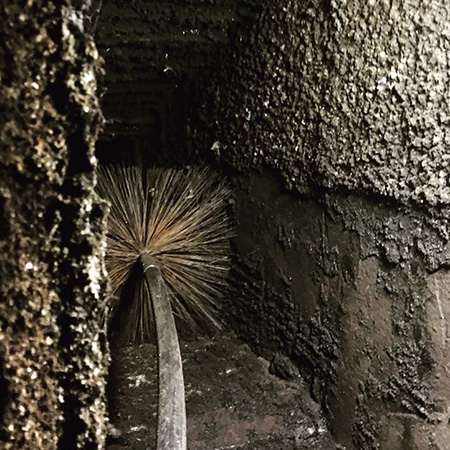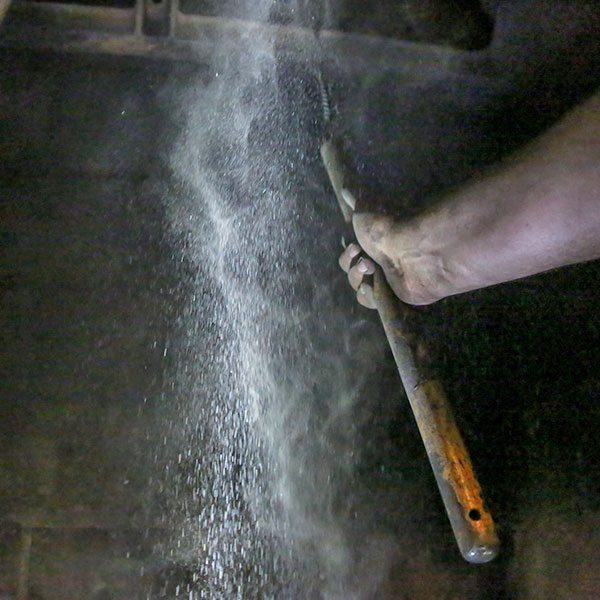Should I Worry About Creosote Buildup?
If you’ve relied heavily on your fireplace a lot the past few winters, you might notice that it’s getting more difficult to use every year. Whether it’s the fire that’s not burning as hot as it used to, smoke coming back into the house or foul odors in the living room, it could be creosote buildup that’s to blame. This blog post looks at what creosote is, why you should worry about it, and what you can do to minimize and eliminate it.

What is Creosote?
Burning wood releases smoke filled with combustion byproducts like chemicals and gases that cool as they go up the chimney, and collect along its walls. This material is called creosote, and it builds up in three stages.
Stage One – In the first stage, creosote is a dust-like coating and can be removed from the chimney with a basic chimney sweeping.
Stage Two – In stage two, creosote turns into black or brown tar flakes that stick to the chimney walls and takes more effort to remove.
Stage Three- The last stage is when the creosote buildup becomes dangerous because it forms a thick tar coating along the chimney walls.
This thick coating is highly flammable and you need a certified chimney sweep to remove it. Experts agree that the best way to prevent creosote from building up to the point it becomes dangerous is to schedule a regular cleaning.
The Dangers of Creosote
Creosote buildup doesn’t only affect your fireplace’s performance; it presents dangers to your home and your health. Here are just a few examples of the dangers of creosote.
Health Problems
Long-term exposure to creosote negatively impacts your health, ranging from mild irritations to more severe problems.
- Skin & Eye Irritation: The chemicals that make up creosote can cause skin irritation, such as rashes or breakouts. Also, getting creosote dust in your eyes can cause light sensitivity or minor chemical burns, which is why you must wear eye protection if you’re cleaning or inspecting your chimney.
- Breathing Problems: Breathing creosote particles can lead to respiratory issues over time, including coughing, trouble breathing, and damage to the lung’s lining.
- Cancer: Although rare, creosote does contain carcinogens, which can put some people exposed to it long-term at risk.
Fire Hazards
While the health impacts are bad enough, they’re not the worst concern homeowners should have regarding creosote buildup. The Chimney Safety Institute of America says that most chimney fires are caused by a dirty chimney, which typically means creosote buildup.
Creosote is corrosive and highly flammable, which will damage the flue liner over time. The flue liner is the barrier protecting your chimney’s combustible components from extreme temperatures. If that’s compromised, it’s not a matter of if you’ll have a chimney fire, but when.
Most people don’t think the temperature in the chimney is hot enough to ignite creosote, but it’s been proven that this substance will ignite from temperatures as low as 451 degrees Fahrenheit. The fire in your fireplace typically burns at 1500 degrees, and your chimney is in danger of igniting with only a ⅛” creosote buildup.
Now, this may seem frightening, and it is because a chimney fire can destroy your home and put lives at risk. However, the good news is that creosote buildup and chimney fires are preventable. The Chimney Safety Institute of America and similar organizations agree that annual chimney cleaning and maintenance performed by a certified chimney sweep is the best way to clear obstructions like creosote and bird nests.
A clean chimney reduces the risk of a chimney fire and ensures your fireplace runs efficiently and makes your fireplace more efficient.
How Can I Minimize Creosote Buildup?
Because creosote is the byproduct of burning wood, it’s nearly impossible to prevent, but you can minimize the effects and slow the buildup, and here are a few tips to do that.
- Burn Seasoned Firewood
Experts recommend that you only burn firewood that’s been seasoned for 6 to 12 months for a better-burning fire and reduced creosote. Why? Because new firewood contains too much moisture, which produces more smoke when it burns, which means quicker creosote buildup. Also, too moist wood decreases the heat fire’s heat output because it uses more energy to boil and evaporate the water than to burn the wood. - Increase Your Fireplace’s Airflow
Positive airflow is a crucial ingredient to a healthy fire. Open the fireplace’s glass doors to draw sufficient airflow to allow your fire to burn off more of the combustible gases that lead to creosote. If your fireplace doesn’t have doors and the fire isn’t burning as it should, try opening a window to allow more air in. - Don’t Use Artificial Logs
Artificial logs are notorious for creating a significant amount of combustion gas, which turns into creosote. Follow the experts’ advice and only use seasoned firewood.
 How Can I Get Rid of Creosote?
How Can I Get Rid of Creosote?
As mentioned, no matter how careful you are, your chimney will experience creosote buildup eventually. However, by hiring a professional chimney service company like Mercer County Chimney Service for annual chimney sweeping, your chimney will remain clean, efficient, and long-lasting.
About Us
Mercer Chimney Service is a licensed Certified Chimney Sweep by the Chimney Safety Institute of America and the National Fireplace Institute. We proudly serve residents in Hamilton, NJ, and Mercer County.
To book an appointment or schedule a consultation, call us at 609-802-5288 or visit our online contact form.


